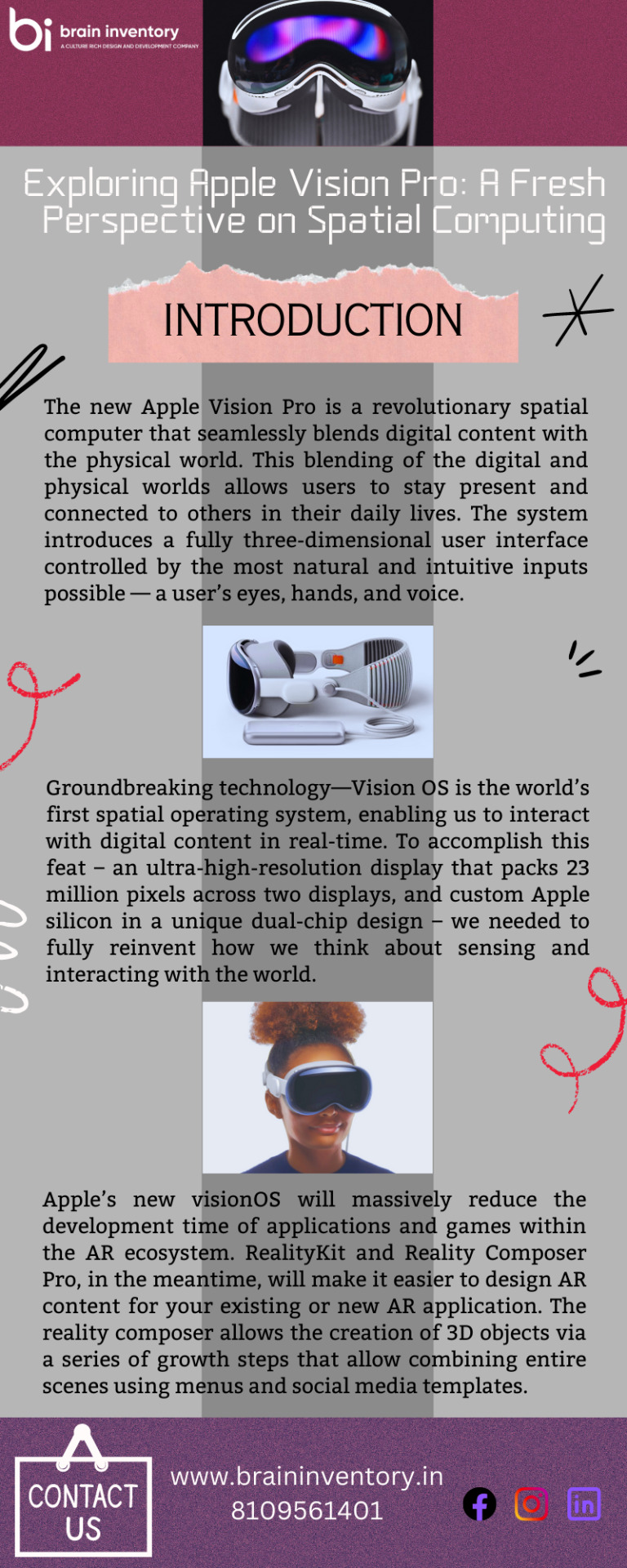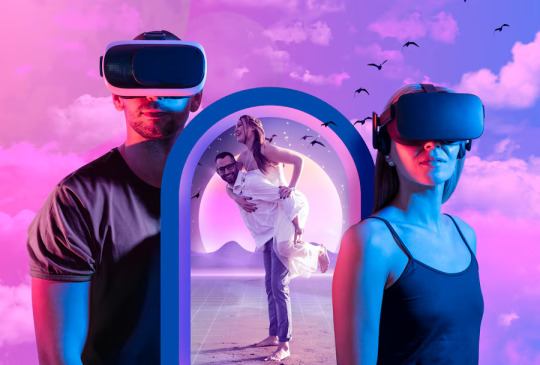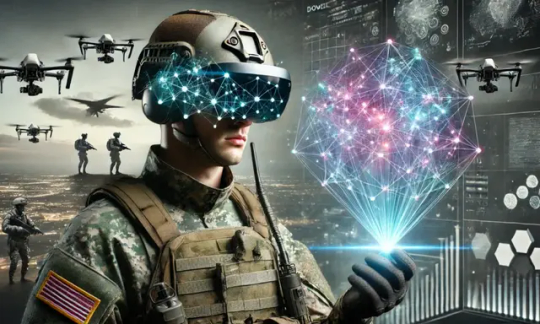#ar application
Explore tagged Tumblr posts
Photo

Apple’s new Vision OS will massively reduce the development time of applications and games within the AR ecosystem. RealityKit and Reality Composer Pro, in the meantime, will make it easier to design AR content for your existing or new AR application. The reality composer allows the creation of 3D objects via a series of growth steps that allow combining entire scenes using menus and social media templates. For More Information: https://braininventory.in/posts/exploring-apples-vision-pro-a-fresh-perspective-on-spatial-computing
0 notes
Text
Harness the Power of Augmented Reality with Vuforia: A Fun, Step-by-Step Guide for Developers
Introduction: Hey there, fellow developers! Ready to dive into the exciting world of augmented reality (AR)? Let’s explore Vuforia, a powerful AR platform that can take your app or game to the next level. By the end of this guide, you’ll be ready to start creating your very own AR experiences. And don’t forget to check out our free eBook at InAugment.com, where we discuss how AR can help your…

View On WordPress
#ar app#ar application#AR apps for kids#AR camera app#Augmented reality creation apps#Best AR apps for iPhone#Civilisations AR
0 notes
Text
1 (one) syzygy character ref sheet done🎉
#by this i mean. just. the character's irl appearance. and their uhh Syzygy avatar appearance#idk what to call it. their virtual appearance? ar appearance? it's hard to sum up#i should probably work out the logistics of how that works more anyway (yay)#also has their name & their username#ex. i did althea and her username is theaologyxxx#i was thinking of adding an inventory onto the ref sheet#bc i was considering having a system where each character in the group has a *SMALL* inventory#and the items they have irl sometimes affect battle#(ex. marina gets a necklace irl -> the necklace exists in the avatar version as an armor/power buff or wtv)#Have i explained how the battles work in the game before. idk oops#im legit js yapping idk if what i've said thus far is coherent BUT WE BALL.#maybe i'll post thea's ref now and post the refs as i make them and just add them all into one bigger post later#side note i am now realizing it is sort of confusing having the actual game be called syzygy and the in-game application be called syzygy#i need to come up w a way to clearly differentiate haha
6 notes
·
View notes
Text
i was reading up on ars goetia for solomon reasons, and i noticed something that piqued my interest. most if not all his pact demons are said to command legions of demons themselves (notably eligos with 60 legions, belial with 80 legions, and paimon with 200 legions). a lot of them even have a whole host of abilities comparable to barbatos’ time-related powers (in fact many are listed to be able to speak past and future, or to manipulate it, much like barbatos).
all this to say i think it would be neat if in canon part of the reason solomon is considered so powerful is not only because he has powerful magic in his own right, but also because he commands an army of 72 demons, most of which have entire armies of their own and special abilities to boot.
#legions by definition are said to be 3000-6000 men#this is of course in reference to roman armies but i mean it’s applicable#which would mean by controlling 72 demons solomon actually has power over thousands if not hundreds of thousands of demons#maybe they are ‘lesser demons’ as referred to in the game but i mean most of his pactmates are referred to as lords dukes kings and princes#in ars goetia#and i don’t think he’d go around making pacts with any weak demons#imagine being diavolo and some dude shows up the devildom and is like hiii :3 i control half your nobility and their personal armies btw#and ur butler too#and he’s not even evil abt it he’s just like sooo can i see the royal library now :>#this is actually so funny to think about#the only thing keeping lucifer from smiting him into oblivion for his wizard shenanigans is the fact that#400000 demons would descend upon him at once like come outside lucifer we just want to talk#solomon obey me#obey me solomon#obey me#txt
93 notes
·
View notes
Video
tumblr
I visited AR House LA this weekend and made some dolphins for the pool! 🐬🌴
this was created in Figmin XR, a creative VR sandbox app ✨
#figmin xr#art#digital art#art video#3d art#dolphins#dolphin#tilt brush#vr#virtual reality#ar#augmented reality#xr#hollywood is like another fucking planet#because directly after this i went next door and crashed a party for wealthy ukranian businesspeople#idek what my life is anymore#bringing imaginary dolphins to life one minute and then walking into hollywood house parties i wasn't invited to in the next#also i wanted to edit WAY more video today#but i was busy with meetings and artist grant/gallery applications ALL DAY#i am dreaming and planning VERY big lately#the grant application is for the LACMA and will be especially huge if i can end up working with them#shooting for the stars right now!!!!
76 notes
·
View notes
Text
Simplify Transactions and Boost Efficiency with Our Cash Collection Application
Manual cash collection can lead to inefficiencies and increased risks for businesses. Our cash collection application provides a streamlined solution, tailored to support all business sizes in managing cash effortlessly. Key features include automated invoicing, multi-channel payment options, and comprehensive analytics, all of which simplify the payment process and enhance transparency. The application is designed with a focus on usability and security, ensuring that every transaction is traceable and error-free. With real-time insights and customizable settings, you can adapt the application to align with your business needs. Its robust reporting functions give you a bird’s eye view of financial performance, helping you make data-driven decisions. Move beyond traditional, error-prone cash handling methods and step into the future with a digital approach. With our cash collection application, optimize cash flow and enjoy better financial control at every level of your organization.
#seo agency#seo company#seo marketing#digital marketing#seo services#azure cloud services#amazon web services#ai powered application#android app development#augmented reality solutions#augmented reality in education#augmented reality (ar)#augmented reality agency#augmented reality development services#cash collection application#cloud security services#iot applications#iot#iotsolutions#iot development services#iot platform#digitaltransformation#innovation#techinnovation#iot app development services#large language model services#artificial intelligence#llm#generative ai#ai
3 notes
·
View notes
Text
itiar update today \></

most recent chapter:
start from the beginning:
(under the cut is a bit more spoilery hehe)

^u^
#ittiar#i think therefore i ar#lil hal#ao3#homestuck#hal strider#and#calliope#:)#btw!#these drawings were done on a chromebook with a trackpad!#chrome canvas as the application#myarts
7 notes
·
View notes
Text
#theintellify#mobile application development#web application development#cloud consulting services#augmented reality#virtual reality#ar vr technology#arvr#ar vr development company#ar vr development services
2 notes
·
View notes
Text
Top SAP Migration Consulting Company
In the ever-evolving landscape of technology and business solutions, finding the right SAP consulting partner is pivotal for organizations seeking optimal efficiency and innovation. SAP, or Systems, Applications, and Products in Data Processing, has become the backbone of many enterprises, streamlining processes and enhancing overall performance. As businesses navigate the vast sea of SAP consulting companies, it’s crucial to identify the crème de la crème — the top SAP consulting company that stands head and shoulders above the rest.
Original Source - https://medium.com/@mobcoder/top-sap-migration-consulting-company-551ca1eecf66Q

#hire flutter developers in usa#it consulting service in india#mobile application development company in india#hire mern stack developers#ui/ux designing company usa#web app development company in usa#best mobile app consulting services#hire dedicated resources in india#hire dedicated flutter app developer#best ar app development company in india#SAP#SAP Migration#SAP Migration Services
2 notes
·
View notes
Text
really hate when technology is made the criteria needed to do any sort of work and then the ppl who make it mandatory don’t have any sort of plan for if it goes wrong
#i hate professors who make you do we codes on your phone for participation are you paying for the phone so i can use it??? no???? ok#*qr codes#i literally cannot do my homework bc the site i was forced to pay $200 to access needs to creatively#make it impossible for me to answer the question bc the design is dogshit#i’m telling my professor but godddddd i hate this i feel for $200 to be able to my homework u should work properly at all times#and now i have to hope i can do it on my phone mind u this is literal assigned homework i was forced to pay $200 to access the site to do#like i swear professors think they’re hip and all they’re just making it harder bc now we need our phones if the computer-originated#application does not work for the out of pocket money i need to spend on it#like mental health my ass y’all are money obsessed bc if u rlly cared ppl would not have to pay that much for shit that easily breaks#and then the professors can’t even do anything u have to call tech support and hope they answer but also professors legit don’t have to#review the work bc their jobs ar électeur and research
2 notes
·
View notes
Video
tumblr
Get ready for a whole new world of mobile app trends with the lightning-fast speeds of 5G!
From seamless video streaming to immersive AR experiences, the possibilities are endless.
https://www.algoworks.com/mobile-app-development-services/
3 notes
·
View notes
Text
This is like the one good use I can think of for AR glasses...

#and I don't mean AR headsets there's plenty of applications for those#I mean regular looking glasses with a screen in them or something
11K notes
·
View notes
Text
Immersive Technologies: Revolutionizing the Future of Engagement

In a rapidly advancing digital age, immersive technologies are taking center stage as the driving force behind transformative experiences across industries. From education to entertainment and healthcare, these technologies, including augmented reality (AR), virtual reality (VR), and mixed reality (MR), are redefining how we interact with the digital and physical worlds.
What Are Immersive Technologies?
Immersive technologies are innovations that blend the digital and physical worlds to create highly interactive experiences. They engage users by overlaying digital elements in the real world (AR), transporting users to entirely virtual environments (VR), or combining elements of both (MR). These technologies rely on advanced hardware and software systems to provide realistic and engaging experiences.
Key Components of Immersive Technologies
Augmented Reality (AR): Enhances the real-world environment with digital overlays. Commonly used in applications like retail try-ons, gaming, and navigation.
Virtual Reality (VR): Immerses users in a fully digital environment, ideal for gaming, training simulations, and virtual tours.
Mixed Reality (MR): Merges real and virtual worlds to produce new environments and visualizations, enabling users to interact with both simultaneously.
Extended Reality (XR): An umbrella term encompassing AR, VR, and MR, representing the full spectrum of immersive experiences.
The Growing Impact of Immersive Technologies
1. Education and Training
Immersive technologies are revolutionizing education by making learning interactive and engaging. VR-based simulations allow medical students to practice surgeries in a risk-free environment, while AR applications bring historical events to life for history enthusiasts.
2. Healthcare
In healthcare, VR is used for pain management, therapy, and surgical training. AR aids in diagnostics by overlaying digital imagery on real-world patients, improving accuracy and outcomes.
3. Retail and E-Commerce
Retailers leverage AR for virtual try-ons, enabling customers to see how clothes, makeup, or furniture look before purchasing. This enhances customer satisfaction and reduces returns.
4. Entertainment and Gaming
The entertainment and gaming industries are at the forefront of immersive technology adoption. VR gaming offers a fully interactive experience, while AR games like Pokémon Go blend the real and digital worlds seamlessly.
5. Real Estate
Virtual tours powered by VR enable prospective buyers to explore properties remotely, saving time and making property viewing more efficient.
Benefits of Immersive Technologies
Enhanced User Engagement: Immersive experiences captivate users, leading to better retention and satisfaction.
Improved Learning Outcomes: Hands-on virtual simulations offer deeper understanding and skill retention.
Cost-Efficiency: Reduces the need for physical resources, such as training equipment or travel.
Increased Accessibility: Enables remote access to experiences and services, breaking geographical barriers.
Data-Driven Insights: Provides valuable data on user behavior and preferences through interactions within immersive environments.
Challenges and Future of Immersive Technologies
Challenges
High Development Costs: Creating immersive applications requires substantial investment in hardware, software, and expertise.
User Adoption: Not all users are comfortable with new technologies, slowing adoption rates.
Hardware Limitations: Devices like VR headsets can be bulky and expensive, limiting accessibility.
Future Prospects
The future of immersive technologies lies in improving hardware affordability, increasing content diversity, and advancing AI integration to create smarter and more personalized experiences. As 5G networks expand, real-time interactivity and accessibility will enhance further.
Conclusion
Immersive technologies are more than just a trend—they are a revolutionary force reshaping industries and redefining engagement. By embracing these innovations, businesses and individuals can unlock new potentials and stay ahead in an increasingly digital world.
Content Source - https://tagbinnews.blogspot.com/2025/01/immersive-technologies-revolutionizing.html
#immersive technologies#augmented reality#virtual reality#mixed reality#future technology#AR applications#VR benefits#MR innovations#tagbin#writers on tumblr#technology#artificial intelligence#tumblr
0 notes
Text
Anthropic and Meta in Defense: The New Frontier of Military AI Applications
New Post has been published on https://thedigitalinsider.com/anthropic-and-meta-in-defense-the-new-frontier-of-military-ai-applications/
Anthropic and Meta in Defense: The New Frontier of Military AI Applications


Imagine a future where drones operate with incredible precision, battlefield strategies adapt in real-time, and military decisions are powered by AI systems that continuously learn from each mission. This future is no longer a distant possibility. Instead, it is happening now. Artificial Intelligence (AI) has evolved from a promising concept to an essential part of modern defense, offering capabilities once confined to science fiction. Its impact is felt across operations, from real-time intelligence analysis to autonomous systems that reduce risks for human personnel.
Companies like Anthropic and Meta are leading this development. Their innovations, including advanced AI tools and immersive training technologies, redefine how militaries prepare, protect, and respond to emerging threats. These advancements enhance efficiency and provide critical support in high-stakes situations where every decision counts.
How AI is Transforming Military Strategies
AI is changing the way militaries plan, operate, and protect. Over the past decade, its role in defense has expanded rapidly. Initially focused on automating basic processes like logistics and maintenance, AI now drives critical functions such as surveillance, predictive analytics, and autonomous operations.
Historical milestones like Project Maven demonstrated AI’s ability to analyze vast surveillance data and identify threats faster than traditional methods. This program fueled the interest in AI’s military potential and highlighted the ethical challenges of using AI in warfare. Today, AI applications in defense include real-time intelligence analysis, advanced cybersecurity measures, and autonomous drones capable of operating in complex environments. Nations like the United States, China, and members of NATO are investing heavily in these technologies to maintain strategic advantages.
AI’s adaptability allows militaries to respond to rapidly changing scenarios, making it indispensable for modern defense systems. However, its adoption raises questions about oversight and ethical use, requiring careful consideration of global policies and guidelines to ensure responsible deployment.
Anthropic’s Contributions to Military AI
Anthropic is a leader in AI safety, focusing on creating systems that are reliable, interpretable, and aligned with human values. Its Claude models, including the latest Claude 3 and 3.5, are designed to process vast amounts of data while adhering to strict safety protocols. These models excel in risk assessment, decision-making, and intelligence analysis, making them highly relevant to military operations.
Anthropic’s partnerships with organizations like Palantir and AWS further extend its capabilities in defense. Palantir’s expertise in data integration and AWS’s secure cloud infrastructure enables Anthropic to deploy scalable AI solutions tailored to military needs. For example, Claude models can analyze intelligence reports, predict potential threats, and assist in formulating strategic responses with speed and accuracy.
A defining feature of Anthropic’s approach is its commitment to ethical AI development. The company prioritizes alignment, ensuring that its models operate transparently and responsibly. This focus on safety and accountability makes Anthropic a trusted partner in military AI, capable of delivering innovative solutions without compromising ethical standards.
Meta’s Role in Defense AI
Meta has become a key player in leading AI for defense. Its Llama models, known for their powerful language processing abilities, play a vital role in intelligence and strategic operations. These models can interpret complex language patterns, decode encrypted messages, and provide actionable insights. This capability helps improve military awareness and decision-making.
Meta’s contributions extend far beyond language analysis. The company is also pioneering using virtual and augmented reality (VR/AR) in defense. VR simulations allow soldiers to train in realistic scenarios without the risks of physical exercises. Meanwhile, AR overlays deliver real-time information to ground troops, helping them make faster and better decisions during operations.
Meta has partnered with major defense contractors like Accenture and Lockheed Martin to bring these technologies into real-world use. By integrating AI into existing military systems, Meta is improving operational efficiency and preparedness. Its focus on creating scalable and flexible solutions ensures these tools can be adapted to various defense needs.
Persistent Memory for Smarter Military Applications
Persistent memory is redefining how AI systems operate in defense. Unlike traditional systems that rely on short-term memory, persistent memory enables AI to retain and recall information over time. This capability is critical for military applications, where continuity and context are essential.
For example, AI systems with persistent memory can analyze historical data to identify patterns and anticipate threats. In autonomous systems like drones and robotic vehicles, persistent memory allows for real-time adaptability, ensuring these technologies can respond effectively to changing environments. Intelligence tools with persistent memory can build comprehensive profiles over time, delivering deeper insights and improving decision-making.
Technologies such as memory-augmented neural networks and vector databases drive these advancements, optimizing data storage and retrieval for military applications. By combining long-term data retention with fast processing speeds, these systems enable more efficient and adaptive defense operations.
Latest Trends and Innovations in Military AI
Military AI is evolving quickly, with new technologies being developed to meet the demands of modern defense. One key advancement is the rise of hybrid memory systems. These systems allow AI to manage both short-term and long-term data effectively. Combining immediate responsiveness with the ability to analyze historical information makes AI more adaptable and reliable in real-time operations.
Another exciting trend is using advanced AI frameworks to improve systems’ handling of complex scenarios. These tools help AI adapt to changing environments, making it more effective in tasks like intelligence analysis and decision-making under pressure. This adaptability is critical for dynamic military situations where speed and accuracy are essential.
Global investments in military AI have surged over the past two years. Data from 2023-2024 shows a clear focus on real-time threat detection, predictive analytics, and immersive training simulations. AI-powered training platforms, for example, now create realistic combat scenarios that help soldiers refine their strategies without physical risks.
Collaboration between governments, tech companies, and defense contractors leads to innovation. Many nations prioritize AI for applications like cybersecurity, autonomous systems, and logistics, further embedding it into defense operations. These advancements are enhancing efficiency and redefining how militaries prepare for and respond to evolving threats.
Challenges and Ethical Considerations
While AI is transforming military operations, its implementation also has significant challenges. A major issue is scalability. Military AI systems must process vast amounts of data quickly, often in high-pressure situations. Building the infrastructure to handle this data efficiently without slowing operations is tough, especially when speed and accuracy are critical.
Privacy and security are equally important. In defense, AI involves handling sensitive military information, which raises questions about who controls the data and how it is protected. Strong encryption and compliance with GDPR are essential to secure this information. Transparency is also important and demands that everyone involved understand how the data is collected, stored, and used.
Another challenge is bias in AI systems. If the AI is trained on flawed or incomplete data, it can lead to inaccurate or unfair outcomes, which could have serious consequences in military contexts. Lessons from past projects, like Project Maven, highlight the need for regular testing, diverse datasets, and ongoing oversight to ensure fairness and accuracy.
Finally, there is a need for global cooperation and clear ethical guidelines. As more nations adopt AI for defense, the need for shared standards and regulations creates risks. Collaborative efforts are needed to ensure AI is used responsibly and doesn’t lead to unintended harm.
The Bottom Line
Anthropic and Meta are leading to new advancements in military AI. Their advanced technologies make defense systems smarter, more efficient, and highly adaptive. From powerful decision-making tools to immersive training solutions, they change how militaries function.
However, this progress brings significant responsibilities and challenges. Issues like scalability, privacy, and fairness must be addressed with care. Clear policies and transparent practices are essential to ensure AI is used responsibly. Global collaboration is also needed to create ethical standards for military AI.
By balancing innovation with accountability, the defense sector can achieve more than just better security. It can build AI systems that are both effective and trustworthy, shaping a safer and more connected future for everyone.
#2023#2024#accenture#adoption#ai#AI development#AI in defense strategies#ai safety#AI systems#ai tools#AI-powered#Analysis#Analytics#anthropic#Anthropic military AI#applications#approach#ar#artificial#Artificial Intelligence#assessment#augmented reality#autonomous#autonomous systems#awareness#AWS#Bias#Building#challenge#change
0 notes
Video
tumblr
an average day at AR House - me (left) working with Adriana Vecchioli (right) on an augmented reality jungle, while a musician plays piano using an AR overlay app in the background
#figmin xr#artists on tumblr#reality mixer#pianovision#art#digital art#3d art#vr#virtual reality#augmented reality#every single one of us wearing headsets lmao#pianovision (the ar piano app) is really cool#every time i go to the house and see dave using it his piano skills have improved incredibly#and the improvements have been over the course of just like... maybe a month or two?#it's very sci fi seeing him hit all the keys while wearing a headset#but yeah!! real life applications of AR being used to improve skills!! and to make learning art more accessible!!!
22 notes
·
View notes
Text
@paulyollyoxxenfree
i think its fun and good that people pick an internet name for themselves these days but i kinda miss when u had some fuckass username and ppl just extrapolated from that i used to be on a star wars forum where my handle was ProfessorMug and ppl just called me prof. u know like there was a guy w vader in his handle so he was just vader
#you can call me Ars#some have called me Snof#someone calls me A Herringbone to this day#I've gotten credit applications for Arsnof A Arsnof#my facial hair the Arstache#my trademark pith helmet the Arschappeau#God I miss TKEP#the kill everyone project#met my spoose there
33K notes
·
View notes